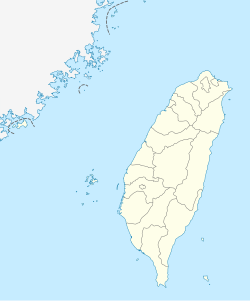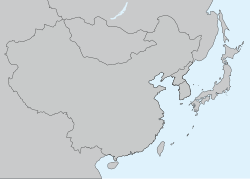This article needs additional citations for verification. (January 2013) |
| Anping Old Fort | |
|---|---|
安平古堡 | |
| Anping, Tainan, Taiwan | |
 Wall of Fort Zeelandia | |
| Coordinates | 23°00′06″N 120°09′39″E / 23.001747°N 120.160919°E |
| Type | Fort |
| Site history | |
| Built | 1624 |
| In use | 1624–1662 |
| Materials | Brick and mortar |
Fort Zeelandia (Chinese: 熱蘭遮城; pinyin: Rèlánzhē Chéng; Pe̍h-ōe-jī: Ji̍at-lân-jia Siâⁿ) was a fortress built over ten years from 1624 to 1634 by the Dutch East India Company (VOC), in the town of Anping (now Anping District of Tainan) on Formosa, the former name of central island of Taiwan, during their 38-year rule over the western part of the island. The site had been renamed several times as Fort Orange (奧倫治城; Pe̍h-ōe-jī: Ò-lûn-tī-siâⁿ), Fort Anping (安平城; Pe̍h-ōe-jī: An-pêng-siâⁿ), and Taiwan City (臺灣城; Pe̍h-ōe-jī: Tâi-oân-siâⁿ); the current name of the site in Chinese is Chinese: 安平古堡; Pe̍h-ōe-jī: An-pêng Kó͘-pó; lit. 'Anping Old Fort'.
During the seventeenth century, when Europeans from many countries sailed to Asia to develop trade, Formosa became one of East Asia's most important transit sites, and Fort Zeelandia an international business center. As trade at the time depended on "military force to control the markets", the value of Formosa to the Dutch was mainly in its strategic position. "From Formosa the Spanish commerce between Manila and China, and the Portuguese commerce between Macau and Japan could by constant attacks be made so precarious that much of it would be thrown into the hands of the Dutch, while the latter's dealings with China and Japan would be subject to no interruptions."[1]
On behalf of the VOC, ships departing from Formosa could head north to Japan, west to Fujian, or south to Vietnam, Thailand, Indonesia, Cambodia, India, Iran or Europe.
- ^ Davidson (1903), p. 13: "Still in those early days trade depended not upon the quality of the goods but upon the military force to control the markets. The Dutch consequently valued the island chiefly on account of its strategical position. From Formosa the Spanish commerce between Manila and China, and the Portuguese commerce between Macau and Japan could by constant attacks be made so precarious that much of it would be thrown into the hands of the Dutch, while the latter's dealings with China and Japan would be subject to no interruptions. The first measure of the new government was to strengthen the defenses of the island. A temporary fort was at once thrown up on a raised sand kink at the entrance of the harbor of Taiwan. But as this structure was of little value it was replaced four years later by Fort Zeelandia (Zealand), a very large and substantial structure. Besides this a small stone redoubt known as Utrecht constructed on a hill "a pistol shot's distance" from its elevation commanded Fort Zeelandia. A second and smaller work called Fort Provintia was built at a subsequent date near the mouth of Formosa river not far distant from Fort Zeelandia. Both these structures were erected on the highest elevations in the vicinity, which enabled signals to be exchanged between them."


